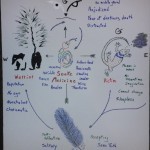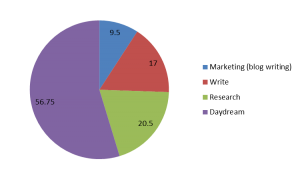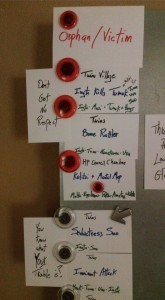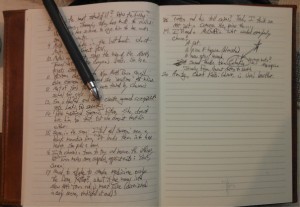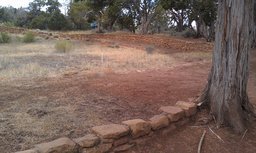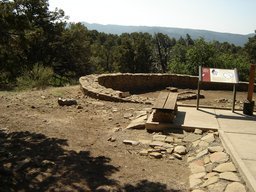Jeff Posey's Blog, page 7
June 16, 2014
Week 18: Writing Novel Number 10, “Medicine Snake”

Vision Board for “Medicine Snake”
By Jeff Posey
It’s been a great week for writing. I just topped 20,000 words, and I’m at the tail-end of Act I.
I struggled to get going, writing maybe 500 words in a session, but then my brain slowly warmed to the story and I would find myself, as I did this morning, looking at the clock and realizing I’d gone an hour past when I expected to stop writing, and I’d written nearly 3,000 words. A good day.
Meanwhile, I’ve been changing and updating my storyboard:
Week18: “Medicine Snake” Storyboard at 20,000 Words, Near the End of Act I
The arrow shows my current writing location (when I took this picture yesterday—today I’ve written down to the second scene from the bottom on the left. That’s where my arrow is now.
Here’s a short excerpt from recent material (all first drafts, uncorrected, unproofed, raw as you can get it from a writer, so all the usual caveats—I reserve the right to change everything). Setting is northwest of Pagosa Springs, Colorado, in the hills above Pagosa Lakes, a thousand years ago:
Life Spiral, Death SpiralIngta let the flames die and after a meal of cold parched corn and dried meat-nut-fruit cakes warmed on stones, they watched the coals.
“What do you see?” Soo asked.
To Uva, he would know how to answer. He didn’t have to pause to think around her, he could be himself. But for Soo, he chewed on a response like Hinti chewed elk jerky.
“It’s like looking at clouds. First it’s one thing, then it becomes something else.”
“Like looking at snake bones.”
He nodded. “Like that, too.”
“You don’t believe in that, I can tell.”
“Could we tell the future, know what choices to make in the future, by looking into this fire? Letting what we see guide us? Even though different people would see different things?”
“Some say yes.”
“What do you think?”
She sat up and hugged her knees. “I think the future is too scary to predict. If we truly knew what awaited us, we would be frozen in terror. Everything would stop. No one would do anything.”
“So you don’t believe the bone rattler either.”
“Did you notice he went around your cast of bones in a life spiral? There was a man like him when I was a child in the canyon who did something like that with stones, and he went the same direction. He looked at his stones and told a story. In the east, he saw a victim, who goes south to find out why. And when he discovers who and why he’s being tormented, he goes on a rampage to the west, where he fights for his life. Just before he gets to the north, he must offer himself for sacrifice, to die for the thing he wants to protect or the person he loves. And then he fights and wins, most of the time, in his stories anyway. But because he’s a victor now, he thinks he knows all right from all wrong, no in between, and he must return to the center for wisdom and enlightenment before the spirits take him away for a better next life.”
Ingta compared what she said to the strange characters Nanatoona saw in the bones Ingta cast. “Did he ever tell the story in reverse?”
“You mean death spiral?”
He waved his hand in front of the coals so she could see his sign for Yes.
“Sometimes. He said all stories go both ways, first in the direction of life, and then in the direction of death. So the end of the story isn’t really enlightenment, but the losing of that as you fall into death. I don’t like thinking about that part.”

June 9, 2014
Week 17: Writing Novel Number 10, “Medicine Snake”

Vision Board for “Medicine Snake”
By Jeff Posey
Go to Week 1: Anasazi Novels: Writing Number 10, “Snake Medicine”: Week 1
This has been a good week. I’m 8,456 words into the first draft and having a blast. Yay!
A quick look at numbers:
Week17: Time to Date on “Medicine Snake”
About 104 total hours, most of it in the daydream stage. I’ve never taken that long to gin up a story. I’ve definitely taken the long, hard road on this one. But it’s fun, so that’s good.
At seventeen hours’ writing time, that’s 497 words per hour. That’s very slow for me. I expect that to pick up now that I’ve started.
I’ve updated my storyboard, too. See the arrow magnet? That’s pointing at the scene I write next.
Week17: Updated “Medicine Snake” Storyboard Opening Scenes
Here’s my opening (subject to change without notice):
“He’s not coming,” said a man with black-pearl teeth. He paced from where his two companions lounged in the shade of the storytelling tree to a straight stick in the ground in full sunlight. The shadow of the stick pointed the length of a man’s thumb to the west.
“Yes, he is,” said Tumok.
“He’s afraid of the revenge of the clan of Molta.” Black-pearl teeth slapped his war club in his left hand as he walked beyond the time stick, glared at all the curious eyes of village people, mainly women and children and old men, hiding and watching, before he turned and paced back to the storytelling tree.
“He should be afraid of me,” said Tumok.
A girl’s sob rose into a cry before an old woman’s voice comforted her and then sang out to the men: “May you die with your eyes closed and wander for all time in darkness, the hands of the wicked dead clutching at you!”
“I should kill that old hag.”
“Leave her be,” said Tumok.
“And that girl whimpers too much. We need a new one.”
“Yeah,” said the other man, short and thin, his first words. “She bleeds too much.”
“What?” asked black-pearl teeth. “You don’t like dirtying your man twig with a little girl blood?” He laughed.
“Forget the girl,” said Tumok. “Watch for Ingta.”
“He said we have to get out before the time stick shows no shadow. I don’t think he’s coming.”
“He will,” said Tumok. “But he’s never been up against a man like me before.”
“What about us?”
“You can protect us from girls that bleed too much. And cursing grandmothers.”
Black-pearl teeth cursed and the little man laughed. Tumok stretched out his legs. He lay back and closed his eyes, patches of sunlight playing over his lids, orange and gray battling back and forth. Tumok smiled. His cousin with the black teeth was right. Ingta should fear not only the club of Tumok, but the bigger club of the clan of old blind Molta. In all the lands from the sacred canyon north to the mountains, there was no more powerful force of men. Even the warriors of the canyon couldn’t compete. Molta had cast his seed wide across the northlands so that in every village, no matter how small, his children and grandchildren and great-grandchildren defended his name. When he became High Priest, anointed by the council of the Southern Alliance, it came as both surprise and vindication for Molta’s life as an outsider, a man without a home as well as without sight. As great-grandnephew of the High Priest, nobody could touch Tumok. Not even Ingta the Twins Keeper, top man of Old Tuwa, the last skywatcher.
“I think that’s him,” said one of his men. Tumok didn’t even register which one. They were interchangeable moron relatives as plentiful as deer in the spring.
When he sat up and looked he saw Ingta sauntering toward them like a man unaware of his imminent misery. Tumok grinned and stood. “You boys watch and learn. If anybody tries to get in the way, stop them. Got that?”
Ingta didn’t look at Tumok and his men, but stopped at the time stick. Squatted and measured the shadow. Half the length of his thumb. “You still have time,” he said.
“All the time in the world,” said Tumok.
Ingta stood and turned his back to Tumok. Shaded his eyes with his hand and looked south.
“Hey,” hissed black-pearl teeth. “That one-handed giant is coming.”
Masi, a head taller than any man Ingta had ever seen, the stump of his missing left hand replaced by a fist-sized river stone wrapped in leather strips that wound to his elbow, walked toward them and planted himself a few steps away. He lifted his chin and gazed into the distance.
Tumok gave a hand sign for his men to watch Masi. Surely the two of them could take a one-handed giant.
“Join us for our midday meal, Twins Keeper,” said Tumok.
“You still have time,” said Ingta.
“Time makes me hungry. Where’s that echo boy? I want some fawn meat.”
Ingta, his back to Tumok, said, “If you start now, I’ll let you go.” Ingta noticed the old matron of the springs watching from a doorway. She complained to Tuwa just yesterday that Ingta had done nothing to make the hot springs a day’s walk to the east safe enough for her to return. But he wasn’t Springs Keeper.
“And if I don’t? What are you going to do?” asked Tumok. “Kill me?”
“I hope he does!” called the old grandmother. The matron made an exaggerated No! sign with her hands. She feared the wrath of Molta more than Ingta did. Making an example of Tumok and his men would protect them more than tolerating the clan. Since the old blind fortuneteller had risen to High Priest, every scion of Molta had turned to splinters and thorns.
Ingta turned and looked at Tumok, still lounging on the ground in the shadow of the storytelling tree. Both men’s hands were empty. Ingta knew where his weapons were, and he could see Tumok’s club hanging from a quick-draw cord through the belt of his loin cloth. Ingta used something similar. “Time’s up.”

June 2, 2014
Writing Novel Number 10, “Medicine Snake”: Week 16

Vision Board for “Medicine Snake”
The Writing of Novel Number 10, Medicine Snake
By Jeff Posey
Go to Week 1: Anasazi Novels: Writing Number 10, “Snake Medicine”: Week 1
This was a big week. I got novel #9, Price on Their Heads, off for second round of reader reviews in both hard copy (paperback Advance Reader Copies, which used to be called Uncorrected Proofs, which, even before that, were called Galley Proofs). And I got everything off to the cover designer.
So, finally, I began to pay more attention to Medicine Snake, my novel #10.
My storyboard now looks like this:
Week16 “Medicine Snake” Storyboard
I’ve been going through the awfully titled but brilliant book on screenwriting, My Story Can Beat Up Your Story: Ten Ways to Toughen Up Your Screenplay from Opening Hook to Knockout Punch (link to Amazon book page). It’s a great way to set up the story and get it launched—and to help keep it on track when the creative monsters start jacking with the story, as they inevitably do (and I want them to).
Here’s what my outline looks like at the moment:
Cast of Characters
Ingta
Molta
HERO
VILLAIN
Keeper of Hero/Villain’s moral compass
PROTECTOR
Nanatoona
PROTECTOR
Yook
Pulls Hero/Villain off path with a different moral compass
DEFLECTOR
Soo, Yook
DEFLECTOR
Nanatoona
Believes and trusts Hero/Villain just as he is
BELIEVER
Masi
BELIEVER
Eyebrow
Challenges Hero/Villain, usually out of cowardice
DOUBTER
Tumok, Tookya
DOUBTER
Blackstone
Reflects on Hero/Villain’s course of action before supporting or not
THINKER
Gawt
THINKER
Amataq
Ally of Hero/Villain who shoots first and asks questions later
FEELER
Pip
FEELER
Póktu
Act 1
Orphan/Victim
Act 1, Part 1
Don’t Get No Respect
5,000
Meet Hero, Stakes, or VillainAt Twins Village Ingta kills bad-guy Tumok of Molta’s clan because he did not get out of town as warned. Aided by Masi. Uva, honoring her vow of silence (given to Tuwa for first year of her skywatcher’s apprencticeship), does not speak to Ingta when he seeks her out for comfort. Ingta feels rejected.
Start here
Hero’s flaw in relation to StakesIn Tuwa’s round chamber at the Twins, the Bone Rattler, Nanatoona, casts snake bones that reveal Ingta’s nature as an inverse black panther, seeing everything in black and white, blind (like Molta) to the obvious: Uva loves him, Tuwa respects him, he has a home and surrogate family there. Ingta thinks he is not worthy because Uva rejects him and he never knew his parents and was unwanted as a child.
Start here
Meet or amplify VillainOld blind Molta, the High Priest, sits in his Chaco council chamber while his grandson, Eyebrow, describes a performance by Amataq and his Kolitsi Warriors, with Póktu present. Molta mentally constructs his plot against Tuwa and Ingta based on his lifelong loathing of skywatchers because they could commune with the sky gods while Molta could not even see the sky.
Start here
Act 1, Part 2
You know what your trouble is?
10,000
Deflector slows hero or pulls off pathIn Twins Big House, sultry Soo Potter says she wants to leave the Twins without being detected because she has lost her creative juices and feels hemmed in by cloying girls with strange religious beliefs.
Start here
Inciting Incident: Hero becomes emotionally involvedYook arrives with warning for Ingta: Kolitsi Warriors are on their way to take him, dead or alive, back to Molta. They will kill on sight anyone who helps or harbors Ingta. Tuwa orders Ingta to escape into the mountains.
Start here
Act 1, Part 3
Calls and Busy Signals
15,000
Statement of Hero’s goal, making obvious to audienceIngta to Tuwa and Uva (eavesdropping): “I’m not Ingta Keeper. I’m Twins Keeper. I am not leaving to protect myself. But I will do anything to protect the Twins, my people, my home.”
Start here
Hero is ready to move forward, but can’tIngta leaves, but lingers within view of the Twins. He sees Uva watching him.
Start here
Act 1, Part 4
Through the Looking Glass
20,000
Villain or Deflector conflict stops hero or threatens emotional stakesSoo appears and says, “Let’s go.”
Start here
Depth of feeling for stakes character or severity of threat becomes evidentIngta follows Soo and is attracted to her. Uva rejected him. Perhaps he should look elsewhere.
Start here
Deflector or Antagonist threatens to take stakes characterGawt catch Ingta and Soo: “Amataq and Kolitsi Warriors have taken Uva.”
Start here
Hero decides he must act to save stakes characterIngta rushes back to the Twins. Tuwa is alive, but shaken. They’ve taken Uva. Soo goes to the hot springs to wait. Ingta goes after Póktu, Amataq, and the Kolitsi Warriors. Masi, Gawt, Kwivi (girl attendant to Soo), and Yook (surprisingly) join him.
Start here
Act 2a
Wanderer/Seeker
Try-Fail Cycle 1: Kick the Dog
30,000
Try-Fail Cycle 2: Which Way is Up?
40,000
Try-Fail Cycle 3: When Life Gives You Lemons…
50,000
Act 2b
Warrior
Try-Fail Cycle 4: …Make Lemonade
60,000
Try-Fail Cycle 5: Inside the Whale
70,000
Try-Fail Cycle 6: Death and Rebirth
75,000
Act 3
Martyr/Victor
What’s the Worst That Can Happen?Big Yes: Ingta escapes with Uva.
NO: The passageways have been blocked by stone.
Start here
Good Guy vs Bad Guy over stakesBig NO!: Molta appears in the dark with a single-flame lamp held by Eyebrow. He begins to laugh. “The last Twins Keeper and the last lady skywatcher, lovers to the end. So may you enjoy eternity.” Póktu and warriors arrive as stone masons begin to block up last passageway.
Final Yes!: Uva Kills stonemasons and Eyebrow. Ingta kills some warriors and Molta. Póktu escapes. They go back to the Twins. They tell Tuwa either they live together as man and wife while they perform their Twins duties, or they will leave. Tuwa asks the Bone Rattler for a decision, and Nanatoona casts his snake bones (mirror opening).
Start here
So—I’m ready to start composing! Stay tuned….

May 29, 2014
Anasazi Archaeology: Thomas Windes Video Explains Tree-Ring Sampling
Thomas Windes (link to bio on New Mexico Office of Archaeological Studies page), thirty-seven-year veteran Anasazi archaeologist with the National Park Service and adjunct with the University of New Mexico, explains the tools and techniques to collect tree-ring samples from ancient (historical and pre-historical) structures. You can see how carefully he acquires and records the samples, which he then sends to The University of Arizona’s Laboratory of Tree-Ring Research (link is to the official page on the university’s site).
Windes (pronounced “Winds”) says tree-chronology has helped build a very precise record of climate and human building with wood for 2,000 years in the American southwest. In helping time the movements of the Anasazi, it’s an indispensable tool.

May 26, 2014
Writing Novel Number 10, “Medicine Snake”: Week 15
Vision Board for “Medicine Snake”
Remember this from Week 13?
Two: Stacks of stones, cairns as tall as a man, begin to appear in unlikely places and no one knows why. Only the humingbirdman knows. And he ain’t telling. (Hey, it’s hard to come up with twenty of these without going a little loopy.)
Stone Witch ProjectIngta’s eyes drifted open and he saw the ghostly shape of a face floating over him. The boy, Hinti, with a glow stick from a fire that he waved in front of him to keep it alive.
“What?” mumbled Ingta.
“Another one,” Hinti said.
“Where this time?”
“Behind Master Tuwa.”
Ingta sat up. “While he was there?”
The boy nodded, and Ingta could barely make it out in the dim light. He scratched his face.
“And he didn’t hear anything? See anything?”
“No.”
Ingta sighed. Who did these things? He stood, wrapped a well-worn skin around his shoulders for warmth. “Show me.”
The boy, still waving his glow stick, which didn’t have much glow left, led him out into cold, still air, morning still too far away to show itself, the world illuminated in the dim blue-white light of stars, no moon. Hinti pointed, and Ingta saw it. A tall, narrow stack of stones directly behind Tuwa, who sat like a sack of dried corn in the middle of his skywatcher’s circle. The stones were on the edge of the circle.
Ingta walked around it, imaging how he might do such a thing without Tuwa hearing, only feet away. It didn’t seem possible.
The stones he recognized, from a pile being shaped and polished for the final facing and top work on the new big house, big ones at the bottom, increasingly smaller to the top. But the height impressed him. He had to look up at the topmost stone. Whoever built it had a gift for stacking and balancing stones, without, obviously, having it crash to the ground and alert the old skywatcher.
“A mystery, isn’t it?” asked Tuwa, without turning from his cardinal direction facing the dark Twins, a sliver of dark sky between the columns of stone.
“You saw and heard nothing?” asked Ingta.
“Only stars and wind.”
Ingta shook his head and walked around the tall stack of stones. How could anyone do this? Why would anyone do this? And who? Ingta looked at the other stacks that had appeared over the last few days. Tuwa ordered them to be left alone, that maybe their pattern of appearance would give an ultimate clue.
“Exactly what I’ve been wondering,” said Tuwa.
He did that sometimes, as if he could read minds, and maybe he could. But even he couldn’t understand the mystery of the stone cairns.
“Reminds me of your hummingbird man,” said Ingta.
“Tootsa,” said Tuwa, still not turning.
“Could he be here? Playing a joke on you?”
“I’ve thought about that. Part of me thinks that must be it. But this feels different than something he would do. He’s a bright spirit. This has a cloud of darkness to it. Do you feel that?”
Ingta did not feel it. He admired people who felt such things, who could walk into a canyon and stop cold because of some foreboding that he couldn’t detect. Welcoming places and tortured places felt the same to him.
“We need to keep Masi or someone out here with you,” said Ingta.
“And the eyes of boys,” said Tuwa.
Ingta nodded. And the eyes of boys. Because they see everything, even if they do not know how to interpret it.
I don’t really know where this is going or if it’s useful for the story. But it sure is fun to write little bits like that. Just release myself to the magic of a story without any idea what it means or where it’s going.
So what does it mean? Stone cairns appearing like that. I’ve not seen the Blair Witch Project (link to Wikipedia), but my son recently watched it said stone cairns appear mysteriously in that movie and scare the characters.
In my last historical Anasazi novel, The Last Skywatcher, not yet released (I’m preparing to release three books in the series at a time, a trilogy of trilogies, nine books, Medicine Snake being the third book of the first trilogy), we meet a grown character, Tootsa (means “hummingbird” in the Hopi language), from my first novel, Less Than Nothing (link to the book’s page on this site). He lives in the middle of nowhere in the rolling sparse-grass desert northeast of Center Canyon where he builds elaborate collections of intricately stacked stone on a low outcrop of rock. He sacrificed some of those stones to help Tuwa, Ingta, and Uva escape the bad-guy canyon warriors in The Last Skywatcher. So he’s a rightful suspect.
But did he do this latest mystery stack of stones? Even I don’t know. Yet.
May 21, 2014
Great Video: Are We Really Here? Did the Anasazi Think This Way?
Maybe I’m not even here, and other crazy beautiful stuff physics told me | Human World | EarthSky.
I always wonder: What did ancient cultures like the Anasazi think about such things as this? They were clearly proficient at measuring the physical world, but they also almost certainly saw and lived in a world not bounded by physics and engineering. This is a great take on the existential angst of anyone with a logical bent.
May 19, 2014
Writing Novel Number 10, “Medicine Snake”: Week 14
Vision Board for “Medicine Snake”
After sleeping on it (or staying awake thinking about it), I realize I missed the point of the “Soo Turncoat Potter” exercise last week. The idea isn’t to explore something that isn’t plausible. It’s to make it plausible by giving the character motivation to do something that is out of their standard character definition. Dismissing it as, “Oh, they would never do that, so I’ll ignore this,” is wrong. The real idea is to find a way to plausibly get the character to do something implausible. It’s a character motivation exercise.
Hence: Do-over.
Soo Turncoat Potter Take 2Sooveni contemplated her feet, dusty and muddy, now drying, from her walk that morning, and now she stood against the white-plastered stone wall of Master Tuwa’s new big house and watched the old man stand and welcome the rising sun.
“Walk with me,” he said as he passed on his daily dawn walk to the informal packed-earth courtyard beneath the oldest piñon tree in the village. Sooveni followed him down the narrow part of the trail, and he motioned for her to walk beside him along the part of the path that followed a straight, narrow ridge.
“You are troubled,” Tuwa said.
Yes, she signed.
Tuwa paused and allowed Soo to climb up and over the low wall with a guardhouse that limited access to the skywatcher’s house and platform above.
The guard stood ready, his eyes focused in the distance.
“How’s the tooth?” Tuwa asked him.
Not good, the guard signed.
Tuwa touched his arm. “Open your mouth to the sun. Let the light shine on the one that hurts. It’s an old Oot remedy.”
The guard nodded and ran his tongue inside his mouth, making his right cheek protrude.
Tuwa and Soo walked in silence, the younger boys of the village watching and racing back to the storytelling tree to tell everyone Tuwa was on his way.
“They are frightened,” Sooveni said. “Of what happened before. That it might happen again.”
Tuwa nodded. “Your thirteen?”
Yes, Soo signed.
The council of thirteen women who ran New North Town. A similar council built up Old North Town before the floods, but warriors from the canyon came and killed them all in a grand display of torture and cannibalism. It ensured the abandonment of Old North Town more than the floods.
“A fear based on reason,” Tuwa said.
“They are afraid to come out of hiding, to meet in town, to even be seen. And without that….” She made a gesture of hopelessness.
“No one will follow an invisible council.”
She nodded.
“You’re worried about New North Town failing like the old one.”
Again, she nodded and looked away.
“But something more than that distresses you.” Tuwa paused and she stopped with him but didn’t meet his eyes.
“They offered protection.”
Tuwa raised his eyebrows. “They?”
“A runner. Not an official one. From Molta.”
Tuwa grinned. “Protection from who?”
Sooveni shook her head. “From them.”
“And if you don’t accept?”
“I don’t know.”
“And if you do?”
She looked down. “I don’t know that, either.”
Tuwa patted her on her shoulder. “Come. Sit with the children. Today I tell them about the inside-out black mountain lion that is blind to everything that is not black or white. It can see only two things at a time. And when something of color or gray comes along, it ignores it entirely.”
Sooveni nodded and joined the children as Tuwa spoke of the blindness of having a closed mind. And she saw then what she must do. Accept the offer from Molta, but not mean it.
Much better.
I also did one of my list of twenty:
Week 14: Twenty Ideas About Anything Medicine Snake
Here are ten of the “Twenty Ideas About Anything Medicine Snake”:
The most wise snake medicine man (or woman) needs to be the ultimate most wise, and they need to be at the new center, one of the north towns. What if it’s Sooveni? A legacy of Tuwa’s wife Chumana, who ran a girls’ school?
It’s a love story. Sooveni and Ingta, though Ingta’s heart is still with Uva.
Soo and Ingta need to nearly die. Several times. Physically or metaphorically or both.
Great POV: What Molta sees. The mental map of a blind man.
Most of Sooveni’s council of thirteen at New North Town were trained in Chumana’s school for girls.
Scene in the snow: Ingta and Soo see a black mountain lion. It locks them into her radar. Soo pulls a bow.
What if the Bone Rattler is most wise? What if he moves into Old North Town, plagued by floods, and sets up as counterpart to Molta (even Tuwa)? As Bone Rattler, he’s diminished and dismissed early in the story, and then vindicated at end.
Tootsa and his tall rock cairns. Oh, yeah. Blair Witch! Blair Witch!
I need a McGuffin (link to Wikipedia—great insight from Alfred Hitchcock). What would everybody chase? A special pot. A special piece of bluestone, raw or worked. A new string record. A sacred bundle from Cahokia (now this is extremely interesting). Jewelry from the Ancient Nations to the south.
Amataq, chief of the Kolitsi Warriors, is Uva’s brother.
That prompted me to clear the character chart from my storyboard and prep it to start taking scenes.
Week 14: Newly Cleared Storyboard for Medicine Snake
I feel like a safecracker, slowly turning the dial, my ear against the metal door listen for clicks and ticks, and I’ve gotten the first two combination digits.
Getting closer! Anasazi Novels will survive and thrive!
May 14, 2014
Ancient cultures in Peru predate Nazcas used desert lines
Archaeologists call these lines by ancient cultures geoglyphs, whether they are meant to be artistic like the famous Nazca Lines or serve a practical purpose, like the lines in the desert drawn by the Paracas people.
The Anasazi had their great roads, impossibly straight across the New Mexican desert in radiating from Chaco Canyon (link to the Solstice Project site). Could they possibly have been influenced by ancient cultures as far to the south as the Paracas and Nazca?
May 12, 2014
Writing Novel Number 10, “Medicine Snake”: Week 13
Vision Board for “Medicine Snake”
How to get into the story. That’s vexing me. Sometimes I have a short, sharp scene in mind, and that spurs the opening and I don’t flop around much on how to start. Other times it’s not so clear. Medicine Snake is not so clear.
I’ve clarified the opposing forces. I’ve personalized the characters. But I’m not sure how to pry my way into the story. I hear all these voices: “Start in the middle of the action!” “Set the opposing action in motion, but the protagonist doesn’t know!” “Do something quirky.”
But I prefer this voice: “Think backward, inside-out, upside-down, inverted, mirrored, like smoke from a burning coal seam.”
I don’t really know what that means, but in honor of Donald Maass (because he tends to do these sorts of things with his writing exercises—link is to his Amazon author’s page), I hereby endeavor to make a list of 20 ways I do not think Medicine Snake can open. And then I’ll pick three and write sample openings. It’s a good way to find hidden nuggets of story ideas.
Ingta and Uva having wild and crazy sex on Tuwa’s sky circle.
Tuwa dying of a heart attack alone in his room.
Gawt, the echo boy, being successfully recruited to work for the dark side of Molta, High Priest of Center Canyon, and Póktu, his chief warrior.
Ingta trudging away from the Twins like a scolded boy, pouting, angry, and powerless.
A black panther sneaking toward the Twins and crouching in the shadows ready to make a great leap and catch anything that moves. Like Uva passing by. While Ingta watches.
Aliens arrive. And they’re pissed for reasons we mere humans will never understand.
Póktu marches every warrior he can muster to attack the Twins. Stupid on his part, because it would likely be the end of the skywatcher system there, and he and Molta and the power structure of Center Canyon would lose sacred sky information and predictions.
Unaffiliated tribes and clans from south of the eastern mountains (from the Twins—the modern South San Juan Mountains) stream into the Twins as refugees from a terror campaign mounted by Póktu and his warriors at the direction of Molta.
A magician casts a spell over Ingta that sends him on a quest into the dark heart of Center Canyon.
One: Sooveni the potter woman, daughter of the prior High Priest of the canyon and head of New North Town (modern ruins at Aztec, New Mexico [link to National Park Service site]) switches alliance with Tuwa and the Twins to Molta and the canyon.
Ingta is trapped in a huge snowstorm east of the Twins with Tookya and Pip. Tookya is a secret agent of Molta and Póktu, and he wants to capture Ingta and take him to Center Canyon. (Hmmm. Rather interesting.)
The Bone Rattler, like old blind Molta before he became High Priest, isn’t the diminutive, inconsequential man he appears to be. He has deep tendrils into the Oots to the north, and the mesa-top farmers and cliff villages to the west, neither of whom have much loyalty to the power structure in Center Canyon or to the south. He uses Tuwa and Ingta to set up himself taking over New North Town from Sooveni, the potter woman. (Hmmm. These are supposed to be things that I think cannot happen. This is too plausible to fit that category. I’m drifting.)
A hundred Spaniards arrive in armor and on horseback five hundred years early. (This is as absurd as aliens arriving.)
Two: Stacks of stones, cairns as tall as a man, begin to appear in unlikely places and no one knows why. Only the humingbirdman knows. And he ain’t telling. (Hey, it’s hard to come up with twenty of these without going a little loopy.)
Molta, the High Priest, decides to cut off the North Towns, the Twins, and the Cliff Villages and he has Póktu and his warriors blockade the North Road. The people to the north rejoice. But the Southern Council is not pleased and Molta is removed from office. In exile, he moves to Old North Town, being abandoned in stages because it’s subject to flooding, and he tries to make allies with Sooveni in New North Town, Tuwa at the Twins, and the two equal chiefs of the Cliff Villages.
Uva ditches skywatcher school to run away with Ingta.
Tuwa sends Ingta on a quest: Kill Póktu.
A rogue patrol of warriors from the land of the Ball Court People to the west invades Anasaziland and Molta masterfully negotiates with them to undermine and destabilize the northern regions. Only Uva saves the Twins from destruction.
Three: The largest and most beautiful specimen of bluestone (turquoise) is brought up from the far eastern mines, and as it is being transported to Center Canyon, it disappears. A massive hunt by Póktu and his warriors ravages the countryside until it is found hidden in an abandoned recess of Old North Town.
A new religion involving people wearing elaborate masks of spirits that lie dormant most of the year takes Anasaziland by storm. Molta, the High Priest, embraces it, to the disgust of his Southern masters, and uses the renewed energy to go on a building campaign unseen for decades. (Not that implausible, really. There is some evidence the Kachina religion swept through the ancient ones, perhaps as early as 1100ish.)
Now pick three: 10, 14, 19. And write flash setups of each. Here’s the first.
Soo Turncoat PotterSooveni picked her two most trustworthy Butterfly Runners and sent them on a secret mission to the High Priest, Molta, in the canyon. She waited, worrying that Master Tuwa, the last skywatcher at the Twins, would find out. She didn’t want to be disloyal to him, he had helped her, especially his top aides, Ingta and Uva. But she saw the reality: The canyon had hundreds of warriors, and Master Tuwa had only a ragtag band of farmers and stonemasons.
The response, when it arrived, carried in the memories of the two girl runners, surprised her: For your protection, we will send two patrols.
That’s all. Not at all what she expected from Molta, the old blind man. It sounded more like what his chief warrior, Póktu, would say. The girls admitted Póktu pressed them to deliver their message to him, and they agreed only if they could also deliver it to the High Priest, which they did.
Within hours, another runner arrived, not a formal one in the old style, with a headdress and running shoes made from the thick skin of elk knees, but a dark-haired man with prominent eyebrows who looked more like the head man of a small, poor village.
“Molta welcomes you,” said the man in an accent Sooveni placed to the south. “He invites you to Center Canyon as his guest, and urges you to leave before Póktu’s warrior patrols arrive.”
Sooveni sat, tense in anger. She should have said nothing. Instead she opened herself up to the manipulation of men who assumed their strength overruled her intelligence.
“We will prepare to leave,” she told the messenger. But what she didn’t tell him was that she had no intention of going to the canyon. Instead, she would go to the Twins and scatter the population of New North Town into the surrounding hills. Póktu’s patrols would find an abandoned town, and they would soon lose interest and leave. And she would confess to Tuwa of her betrayal, and beg him for protection, for an alliance against the canyon. She’d chosen badly.
She heard Tuwa’s voice ask, “What did you expect they would do?”
“Embrace me,” she imagined saying. “In exchange for my pottery.”
Tuwa laughed at her. “They will imprison you. Old Molta plays the old wise man, gentle and unassuming, but he schemes and manipulates like a fool who believes the full measure of life derives from what you can force others to do for you.”
She shook her head. Maybe she should move north and west to the cliff villages, start anew farther away from the gravity of the canyon.
Hmmm. I don’t really like this. Feels unnatural. This isn’t what Sooveni would do. She hates the canyon. Her father is the former High Priest, murdered by Póktu, and she had been glad. Her father abused her, held her prisoner, starved her and tried to force her to make exquisite pots for his too-many wives. Instead she ran, and Tuwa, Ingta, and Uva were the only ones who helped her and showed her mercy.
So I reject this version.
I’ll keep working it because it’s what I do.
May 7, 2014
Mesa Verde Anasazi: Lake or Ritual Plaza?
An interesting new study about the Mesa Verde (link to National Park Service site), Colorado, Anasazi just released. See it here on LiveScience.com: ‘Mummy Lake’ Used for Ancient Rituals, Not Water Storage
In Colorado’s Mesa Verde National Park, a large 1,000-year-old structure long thought to be an Ancestral Puebloan water reservoir may not have been built to store water after all, a new study suggests.
Mesa Verde Lake or Ritual Space? Photo by Jeff Posey
There’s a similar, though much smaller, open-air round house (kiva seems the wrong word when it’s ground level and there’s no top) at Chimney Rock National Monument (link to official national monument site) near Pagosa Springs, Colorado.
Chimney Rock National National Monument Open-Topped “Kiva?” Photo by Jeff Posey
The most interesting part to me is this section near the bottom of the article:
Two decades ago, researchers studying the Manuelito Canyon Community of New Mexico discovered the Ancestral Puebloan population had an evolving ritual landscape. Over the centuries, the Manuelito people relocated the ritual focus of their community several times. Each time they moved, they built ceremonial roads to connect their retired great houses and great kivas to the new complexes.
Benson and his colleagues suspect the same thing happened at Mesa Verde. Mummy Lake was built as early as A.D. 900, around the same time as the rest of the Far View group of structures; Cliff Palace and Spruce Tree House, on the other hand, date to the early 1200s. The researchers think the community relocated to the latter structures between A.D. 1225 and 1250, and connected their past with their present using the ceremonial roads.
We know, of course, about the road system in Chaco Canyon (link to the Solstice Project site). On the surface, therefore, this sounds highly plausible.
But we always must imagine this kind of thing with caution. Since the beginning of archaeology, there has been a tendency to classify anything we don’t understand as “ritual,” which has a religious connotation. It very well could be this is simply a place where they held dances and plays, and it was more entertainment than religious.

